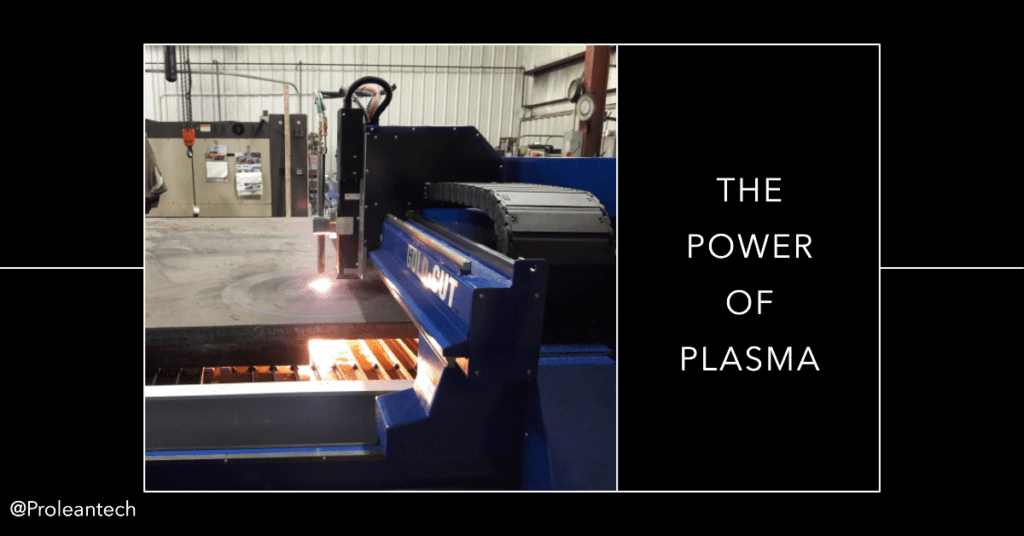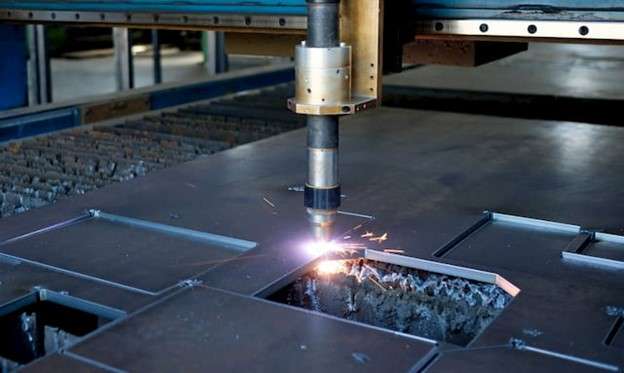
Titanium, a metal renowned for its unique attributes, including superior strength, lightweight, and outstanding corrosion resistance, has become an integral component across a myriad of industries. From its broad application in the aerospace and automotive sectors to its critical use in the medical field, titanium’s demand is unquestionable. Titanium possesses a high melting point and robust strength, which can introduce obstacles during the cutting process. Despite these challenges, various cutting technologies, including plasma cutting, have been employed over the years.
However, one aspect that has often been the subject of scrutiny is the processing of titanium, particularly cutting it. The question at hand is, can plasma cut titanium? This article will take an extensive look into plasma cutting technology and its application to titanium, diving deep into the process, challenges, and potential alternatives.
Read more: CNC machining of Titanium & Alloys
The Basics: Understanding Plasma Cutting

Plasma cutting is a process frequently deployed in the metal fabrication industry. At its core, it involves the use of plasma – a high-temperature, electrically conductive gas, to cut through metals. This state of matter is generated by adding energy (in the form of heat) to a gas, causing its particles to become ionized.
The fundamental components of a plasma cutting system include a power supply, an arc starting console, and a torch. The power supply regulates the machine’s current and maintains the plasma arc throughout the cutting process. The arc starting console produces a high-frequency, high-voltage circuit to initiate the plasma arc, while the torch concentrates the plasma arc and delivers it to the metal.
Despite plasma cutting being a well-established method for cutting metals like steel, aluminum, and copper, its compatibility with titanium is less straightforward. The table below presents a brief overview of the plasma-cutting process:
Table 1: The Plasma Cutting Process
| Step | Description |
|---|---|
| 1. Initiation | A high-frequency, high-voltage circuit from the arc starting console initiates the plasma arc. |
| 2. Concentration | The torch concentrates and directs the plasma arc onto the metal. |
| 3. Cutting | The high-temperature plasma arc melts the metal, and the force of the plasma gas blows away the molten material, creating a cut. |
Related to:
- The Diverse Applications of Aluminum Plasma Cutting
- Plasma Cutting Stainless Steel: Techniques, Grades, and Advantages
Can Plasma Cut Titanium? The Short Answer
Simply put, yes, plasma can cut titanium. Nevertheless, the process is not as simple or straightforward as cutting more conventional metals. Titanium, with its high melting point and robust strength, can pose significant challenges to the plasma-cutting process.
When subjected to the extreme temperatures of plasma cutting, titanium can react with the surrounding air to form titanium dioxide, a hard, brittle compound that can compromise the quality of the cut. Moreover, titanium’s high thermal conductivity and low mass density can cause heat to dissipate rapidly from the cut zone, potentially leading to a narrow, difficult-to-control kerf.
Despite these challenges, with the right plasma system and process parameters, plasma cutting can be a viable method for processing titanium. Particularly for larger-scale operations or where precision is not the utmost priority, plasma cutting offers a fast, cost-effective means of slicing through titanium.
To summarize:
- Plasma cutting can technically be cut through titanium.
- The process can be more challenging than with other metals due to titanium’s physical properties.
- The formation of titanium dioxide and rapid heat dissipation can impact the cut’s quality.
- Despite the challenges, with the right setup, plasma cutting can still be a practical method for cutting titanium.
The Challenges and Solutions in Plasma Cutting of Titanium
As touched on earlier, plasma-cutting titanium comes with unique challenges. The most critical issue stems from the fact that when titanium is exposed to high temperatures in an oxygen-rich environment (such as in plasma cutting), it forms a hard, brittle layer of titanium dioxide on its surface. This layer can adversely affect the cut’s quality and cause premature wear on the cutting equipment.
Additionally, the high thermal conductivity of titanium means heat is rapidly drawn away from the cutting zone. This rapid heat dissipation can make it challenging to maintain a stable and concentrated plasma arc, further complicating the cutting process.
Despite these obstacles, with proper procedures and equipment, plasma-cutting titanium can be successful. Let’s delve into some of the potential solutions:
Table 2: Challenges and Solutions in Plasma Cutting of Titanium
| Challenge | Solution |
|---|---|
| Formation of Titanium Dioxide | The use of shielding gas can help to minimize the formation of titanium dioxide. Shielding gases like argon or helium can create a protective atmosphere around the cutting zone, reducing the reaction between titanium and oxygen. |
| High Thermal Conductivity | Employing a higher-power plasma system can help overcome titanium’s high thermal conductivity. A high-power system can deliver a more concentrated and hotter plasma arc, enabling more effective cutting. |
Considering the Alternatives: Water Jet and Laser Cutting
While plasma cutting can be used for titanium, it’s not always the most suitable method, especially where precision and minimal heat affectation are paramount. Two potential alternatives worth considering are water jet cutting and laser cutting.
Water jet cutting employs a high-pressure jet of water, sometimes mixed with an abrasive substance, to cut through material. Because it doesn’t generate heat, water jet cutting eliminates the risk of heat-induced deformities, making it a suitable method for cutting titanium.
Laser cutting, on the other hand, uses a focused laser beam to melt, burn, or vaporize the material, producing highly accurate and clean cuts. While it does produce heat, the heat affectation zone is typically minimal due to the high concentration of the laser beam.
Here’s a summary of these alternative methods:
Table 3: Alternative Methods for Cutting Titanium
| Method | Description |
|---|---|
| Water Jet Cutting | Uses a high-pressure water jet (often mixed with abrasive) to cut through the material. No heat is involved, reducing the risk of heat-related distortions. |
| Laser Cutting | Uses a focused laser beam to cut through the material. While it does generate heat, the high concentration of the laser minimally affects the surrounding material. |
Each method has its benefits and trade-offs, and the choice ultimately depends on the specific application and requirements. Factors such as precision, speed, cost, and material thickness all play a role in determining the most suitable cutting method.
Related to: Which cutting method is better – plasma or laser? Ultimate Guide 2024
When is Plasma Cutting Titanium Suitable?
Plasma-cutting titanium may not be the best choice for every application due to its heat-intense nature and the challenges associated with titanium’s reactive properties. However, there are situations where plasma cutting is indeed a suitable method.
Generally, plasma cutting is more appropriate for thicker titanium sheets where high precision isn’t paramount. For projects where speed is critical, and a higher degree of edge roughness is acceptable, plasma cutting can be the more economical and faster option. This is especially true when compared to water jet cutting, which, although accurate and cool, can be significantly slower.
To help decide when plasma cutting is suitable, consider these factors:
Table 4: Suitability Factors for Plasma Cutting Titanium
| Factor | Suitability for Plasma Cutting |
|---|---|
| Thickness of Material | Plasma cutting is typically more suitable for thicker titanium sheets. |
| Speed | For applications where speed is critical, plasma cutting can be a faster option. |
| Edge Quality | If a higher degree of edge roughness is acceptable, plasma cutting is suitable. |
Related to: Applications of Titanium Plasma-Cutting
Summing Up
Plasma cutting is capable of cutting titanium, but it requires a unique set of challenges and precautions due to titanium’s reactive nature and high thermal conductivity. While alternative methods like water jet and laser cutting may be more suitable for certain applications, plasma cutting offers its own set of advantages in speed and cost-effectiveness for thicker sheets. The key is to understand the specific demands of each project and to choose the cutting method that best fits those needs.
Prolean’s Plasma Cutting Services are the ideal solution for precision-engineered components made from titanium. At Prolean, we utilize state-of-the-art equipment to provide high-quality, custom components in a variety of materials, including titanium. Our skilled technicians ensure that each piece meets stringent quality standards, delivering excellent performance, durability, and fit.
FAQs
Can plasma cut titanium?
Yes, plasma can cut titanium, although the process presents unique challenges due to titanium’s reactive nature and high thermal conductivity.
What are the alternatives to plasma cutting for titanium?
The water jet and laser cutting are two viable alternatives to plasma cutting for titanium. These methods can provide greater precision and minimize heat-affected zones.
What safety measures should be in place when plasma-cutting titanium?
Safety measures include proper ventilation, the use of shielding gas, having a Class D fire extinguisher on hand, and ensuring operators are adequately trained in safety protocols.
Is plasma cutting suitable for all titanium applications? Not necessarily. While plasma cutting can be faster and more cost-effective for thicker sheets, other methods like laser or water jet cutting may be more suitable for applications requiring high precision or minimal heat affectation.




Can you be more specific about Power for laser cutting approximately 1 mmm thick titanium, I still have some doubts. Hope you can help me.
Hey Alex, It’s important to note that the actual power needed can vary based on factors such as the specific type of titanium alloy, desired cutting speed, and quality requirements. Roughly, a 500-watt laser may suffice for cutting 1mm titanium.